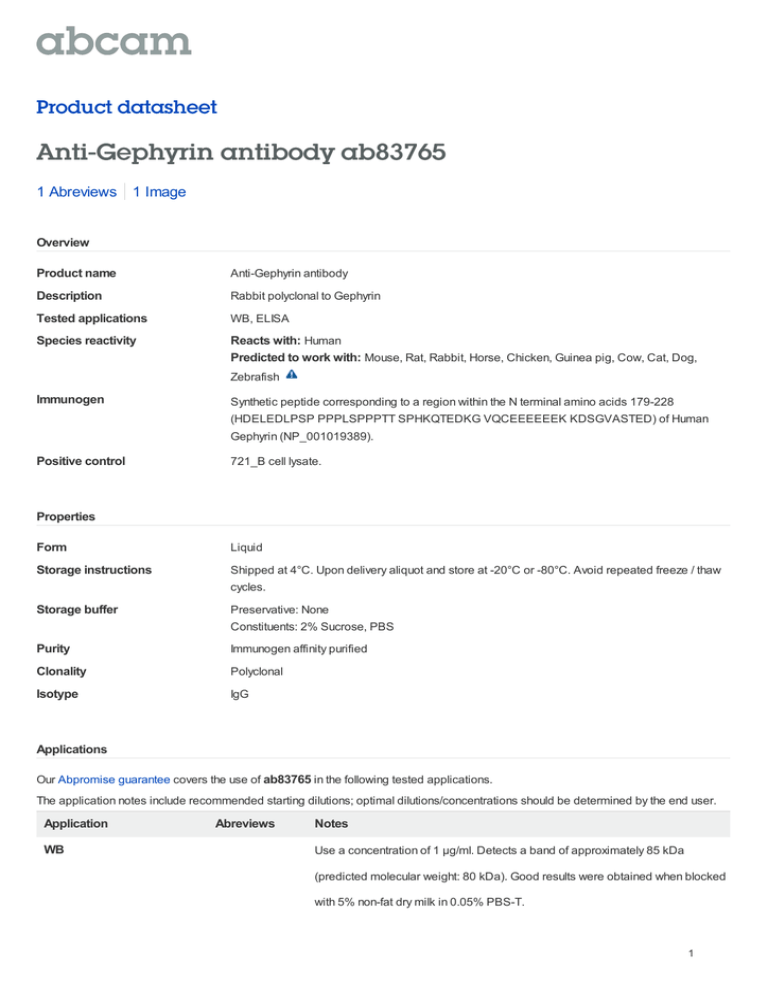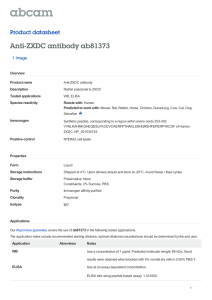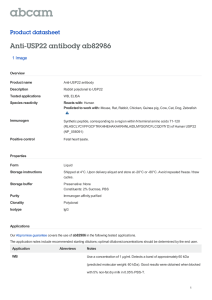Anti-Gephyrin antibody ab83765 Product datasheet 1 Abreviews 1 Image
advertisement

Product datasheet Anti-Gephyrin antibody ab83765 1 Abreviews 1 Image Overview Product name Anti-Gephyrin antibody Description Rabbit polyclonal to Gephyrin Tested applications WB, ELISA Species reactivity Reacts with: Human Predicted to work with: Mouse, Rat, Rabbit, Horse, Chicken, Guinea pig, Cow, Cat, Dog, Zebrafish Immunogen Synthetic peptide corresponding to a region within the N terminal amino acids 179-228 (HDELEDLPSP PPPLSPPPTT SPHKQTEDKG VQCEEEEEEK KDSGVASTED) of Human Gephyrin (NP_001019389). Positive control 721_B cell lysate. Properties Form Liquid Storage instructions Shipped at 4°C. Upon delivery aliquot and store at -20°C or -80°C. Avoid repeated freeze / thaw cycles. Storage buffer Preservative: None Constituents: 2% Sucrose, PBS Purity Immunogen affinity purified Clonality Polyclonal Isotype IgG Applications Our Abpromise guarantee covers the use of ab83765 in the following tested applications. The application notes include recommended starting dilutions; optimal dilutions/concentrations should be determined by the end user. Application WB Abreviews Notes Use a concentration of 1 µg/ml. Detects a band of approximately 85 kDa (predicted molecular weight: 80 kDa). Good results were obtained when blocked with 5% non-fat dry milk in 0.05% PBS-T. 1 Application Abreviews ELISA Notes Use at an assay dependent concentration. ELISA titre using peptide based assay 1/1562500. Target Function Microtubule-associated protein involved in membrane protein-cytoskeleton interactions. It is thought to anchor the inhibitory glycine receptor (GLYR) to subsynaptic microtubules (By similarity). Catalyzes two steps in the biosynthesis of the molybdenum cofactor. In the first step, molybdopterin is adenylated. Subsequently, molybdate is inserted into adenylated molybdopterin and AMP is released. Pathway Cofactor biosynthesis; molybdopterin biosynthesis. Involvement in disease Defects in GPHN are the cause of molybdenum cofactor deficiency type C (MOCOD type C) [MIM:252150]. MOCOD type C is an autosomal recessive disease which leads to the pleiotropic loss of all molybdoenzyme activities and is characterized by severe neurological damage, neonatal seizures and early childhood death. Defects in GPHN are a cause of startle disease (STHE) [MIM:149400]; also known as hyperekplexia. STHE is a genetically heterogeneous neurologic disorder characterized by muscular rigidity of central nervous system origin, particularly in the neonatal period, and by an exaggerated startle response to unexpected acoustic or tactile stimuli. Sequence similarities In the N-terminal section; belongs to the moaB/mog family. In the C-terminal section; belongs to the moeA family. Cellular localization Cell junction > synapse. Cell junction > synapse > postsynaptic cell membrane. Cytoplasm > cytoskeleton. Cytoplasmic face of glycinergic postsynaptic membranes. Anti-Gephyrin antibody images Anti-Gephyrin antibody (ab83765) at 1 µg/ml + 721_B cell lysate at 10 µg Secondary HRP conjugated anti-Rabbit IgG at 1/50000 dilution Predicted band size : 80 kDa Observed band size : 85 kDa Western blot - Gephyrin antibody (ab83765) Please note: All products are "FOR RESEARCH USE ONLY AND ARE NOT INTENDED FOR DIAGNOSTIC OR THERAPEUTIC USE" Our Abpromise to you: Quality guaranteed and expert technical support Replacement or refund for products not performing as stated on the datasheet Valid for 12 months from date of delivery 2 Response to your inquiry within 24 hours We provide support in Chinese, English, French, German, Japanese and Spanish Extensive multi-media technical resources to help you We investigate all quality concerns to ensure our products perform to the highest standards If the product does not perform as described on this datasheet, we will offer a refund or replacement. For full details of the Abpromise, please visit http://www.abcam.com/abpromise or contact our technical team. Terms and conditions Guarantee only valid for products bought direct from Abcam or one of our authorized distributors 3

